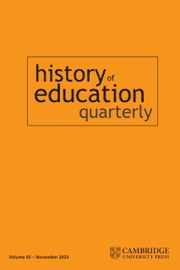No CrossRef data available.
Article contents
The Fear of Bilingual Superpowers
Published online by Cambridge University Press: 20 November 2025
Abstract

Information
- Type
- Forum
- Information
- Copyright
- © The Author(s), 2025. Published by Cambridge University Press on behalf of History of Education Society.
References
1 The White House, “Designating English as the Official Language of The United States,” Presidential Actions, March 1, 2025, https://www.whitehouse.gov/presidential-actions/2025/03/designating-english-as-the-official-language-of-the-united-states/; The White House, “Improving Education Outcomes by Empowering Parents, States, and Communities,” Presidential Actions, March 20, 2025, https://www.whitehouse.gov/presidential-actions/2025/03/improving-education-outcomes-by-empowering-parents-states-and-communities/; Kalyn Belsha, “Trump Education Department Decimates Office Serving 5 Million English Learners in Public Schools,” Chalkbeat, March 21, 2025, https://www.chalkbeat.org/2025/03/21/trump-education-department-dismantles-office-for-students-learning-english/; Mark Sherman, “Supreme Court Allows Trump to Lay Off Nearly 1,400 Education Department Employees,” Associated Press, July 14, 2025, https://apnews.com/article/supreme-court-trump-education-layoffs-9370415531185092341b16a6bfea9344.
2 Notable examples of Chicanx educational historiography education include Carlos K. Blanton, George I. Sanchez: The Long Fight for Mexican American Integration (New Haven, CT: Yale University Press, 2014); Rubén Donato and Jarrod S. Hanson, The Other American Dilemma: Schools, Mexicans, and the Nature of Jim Crow, 1912‒1953 (Albany: State University of New York Press, 2021); David G. García, Strategies of Segregation: Race, Residence, and the Struggle for Educational Equality (Berkeley: University of California Press, 2018); Philis Barragán Goetz, Reading, Writing, and Revolution: Escuelitas and the Emergence of a Mexican American Identity in Texas (Austin: University of Texas Press, 2020); Gilbert G. González, Chicano Education in the Era of Segregation (Philadelphia: Balch Institute Press, 1990); Rosina Lozano, An American Language: The History of Spanish in the United States (Berkeley: University of California Press, 2018); Laura K. Muñoz, Desert Dreams: Mexican Arizona and the Politics of Educational Equality (Philadelphia: University of Pennsylvania Press, 2024); Danielle R. Olden, Racial Uncertainties: Mexican Americans, School Desegregation, and the Making of Race in Post-Civil Rights America (Berkeley: University of California Press, 2022).
3 Dennis E. Baron, The English-Only Question: An Official Language for Americans? (New Haven, CT: Yale University Press, 1990).
4 Jonathan Rosa and Nelson Flores, “Unsettling Race and Language: Toward a Raciolinguistic Perspective,” Language in Society 46, no. 5 (Sept. 2017), 621–47.
5 See “A Bilingual Future in New Mexico,” in Lozano, An American Language, 234–43; Muñoz, Desert Dreams, 14–15; Olden, Racial Uncertainties, 190. Olden describes how some Mexican Americans struggled with the idea of “bilingual-bicultural education” because they believed it cast them as “different” and outside the “American mainstream.”
6 US Department of Justice, Office of Public Affairs, “Celebrating the 50th Anniversary of Lau v. Nichols: The Justice Department’s Civil Rights Division Continues to Enforce the Rights of English Learners in the Nation’s Public Schools,” Feb. 5, 2024, https://www.justice.gov/archives/opa/blog/celebrating-50th-anniversary-lau-v-nichols.
7 Sophia L. Ángeles and Kyle Halle-Erby, “‘We Call Them International Students’: The Consequences of the Newcomer and International Student Labels for Immigrant Students in Public Schools,” Anthropology & Education Quarterly, May 5, 2025, https://doi.org/10.1111/aeq.70021; see also US Department of Justice, Office of Public Affairs, “Celebrating the 50th Anniversary of Lau v. Nichols.”
8 Clif Stratton, Education for Empire: American Schools, Race, and the Paths of Good Citizenship (Oakland: University of California Press, 2016).
9 See, in particular, González, Muñoz, and Stratton, although most scholars who examine immigrant education agree that language acquisition and vocational skills were central to English-learner pedagogies in the nineteenth and twentieth centuries.
10 Jaime Alanís, “Blowouts: Chicanismo and Latinidad in Late-1960s Chicago,” in Latina/o/x Education in Chicago: Roots, Resistance, and Transformation, ed. Isuara Pulido, Angelica Rivera, and Ann M. Avilés (Urbana: University of Illinois Press, 2022), 88; Lilia Fernández, Brown in the Windy City: Mexicans and Puerto Ricans in Postwar Chicago (Chicago: University of Chicago Press, 2012); Mirelsie Velázquez, Puerto Rican Chicago: Schooling the City, 1940–1977 (Urbana: University of Illinois Press, 2022).
11 Ileana Najarro, “Here’s Why Miguel Cardona Is Pushing Multilingual Education,” Education Week, Nov. 17, 2023, https://www.edweek.org/teaching-learning/heres-why-miguel-cardona-is-pushing-multilingual-education/2023/11. USDE Secretary Miguel Cardona referred to bilingualism and multilingualism as a “superpower” and used the term in the OLEA initiative, “Being Bilingual is a Superpower,” which invested over $150 million in securing Native language programming and training bilingual educators.
12 Mexican American and Spanish-speaking teachers in the US Southwest have developed dual-language curricula and pedagogy since the nineteenth century. For example, Aurelia Borquez de Whenthoff’s Spanish-language readers were adopted by California public schools and purchased by libraries across the nation, including the New York Public Library (see Muñoz, Desert Dreams, 44); National Education Association, The Invisible Minority … Pero no Vencibles: Report of the NEA-Tucson Survey on the Teaching of Spanish to the Spanish-Speaking (Washington, DC: Department of Rural Education, National Education Association, 1966); Yolanda Leyva, “María Luisa Legarra Urquides,” in Latinas in the United States: An Historical Encyclopedia, vol. 3, ed. Vicki L. Ruiz and Virginia Sánchez Korrol (Bloomington: Indiana University Press, 2006), 779‒80; Maritza De La Trinidad, “Mexican Americans and the Push for Culturally Relevant Education: The Bilingual Education Movement in Tucson, 1958–1969,” History of Education 44, no. 3 (2015), 316–338. De La Trinidad beautifully details the history of “Spanish for Spanish speakers” and the collaboration among the four founding teachers: Maria L. Urquides, Adalberto Guerrero, Henry “Hank” Oyama, and Rosita Cota.
13 González, Chicano Education in the Era of Segregation, 201; Montserrat Garibay, “Message from Montserrat (January 2025),” National Clearinghouse for Language Acquisition, Office of English Language Acquisition, US Department of Education, January 16, 2025, https://ncela.ed.gov/blog/2025-01-16-announcement-a-message-from-montserrat-january-2025#:∼:text=Happy%20New%20Year!,few%20years%20a%20remarkable%20experience.

